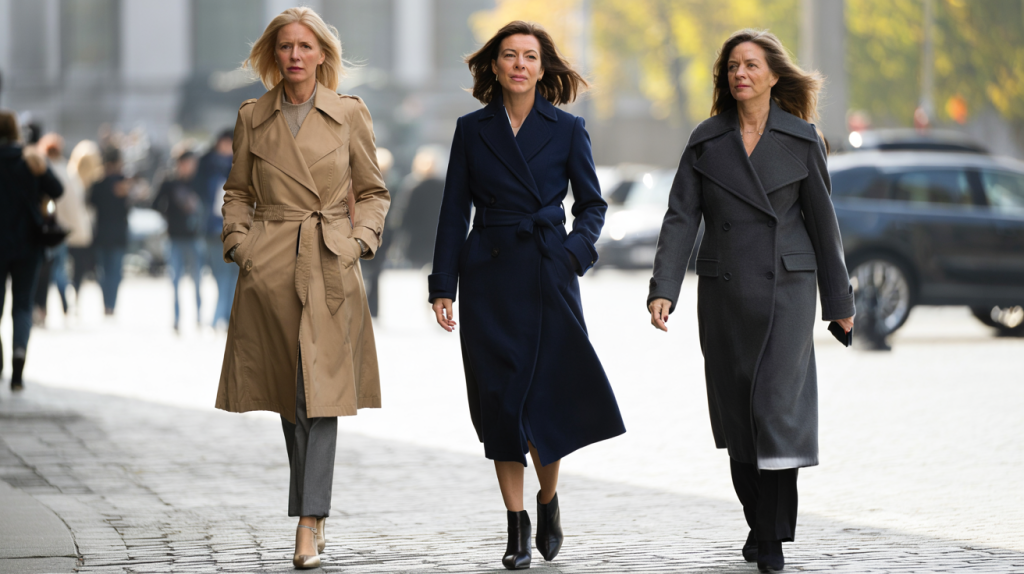One coat can change everything. Past 40, the right cut sharpens posture, lifts outfits, and gives that confident stride that gets noticed before anything else. The wrong cut does the opposite. Shoulders droop, silhouette sinks, proportions get lost. The good news is simple and practical: a few design choices do most of the heavy lifting.
This is about strategy, not trends. Body changes, lifestyle shifts and colder commutes push a coat from accessory to daily armor. The outer layer sets the tone of a look, so the first decision is about proportion and structure. Then come fabric, color, and details that quietly reshape the figure. And yes, there is a clear answer to which cuts work best after 40, but the ground rules come first.
The Best Coat Cuts After 40: Start With Fit and Proportion
The eye reads vertical lines fast. Clean seams, a lightly defined waist and a sharp shoulder build height and calm. Start with the shoulder seam kissing the end of the shoulder bone, not beyond. A soft shoulder still needs clarity, which prevents a slouchy feel.
Length matters more than size on the label. For reference, the average woman in England stands at 161.6 cm. Source: NHS Digital, Health Survey for England 2019. On that height, a coat that ends around mid thigh to just below the knee creates the most balanced look in flats or low heels. Taller frames can drop to mid calf without losing momentum.
Lapels speak to the face. Slim lapels tidy a petite frame. Medium lapels stabilise a fuller bust. Big peak lapels add presence when a blazer would also look sharp. Keep pockets flat and placed near the hip bone to avoid bulk where nobody wants bulk.
Trench, Wrap, or Peacoat: Which Silhouette Flatters After 40
Now the answer lands. Three silhouettes deliver every day elegance, with history and practicality on their side. The trench coat earned its reputation in 1914 when Thomas Burberry supplied weatherproof gabardine for officers. Source: Burberry Heritage Archive. The wrap coat became an icon in 1981 with the Max Mara 101801, a soft structured design that flatters curves. Source: Max Mara. The peacoat brings naval neatness and warmth without length overload.
Each suits a different need, and choosing becomes easy when matching body and lifestyle to details.
- Trench coat: best for straight or balanced shapes. Look for a storm flap, back vent, removable belt. Tie the belt at the back to open the front and lengthen the body when layering.
- Wrap coat: ideal for curves or a fuller bust. A fixed tie at the natural waist draws the eye in and trims the midsection without squeezing.
- Single breasted tailored coat: sharp on everyone. One or two buttons, a light V shape, and vertical darts create clean lines under dresses or denim.
- Peacoat: perfect for petites or busy days. Double rows add structure. Stop at high hip or low hip for balance with wide leg trousers.
- Chesterfield coat: a sleek option for offices. Notch lapel, hidden fastening, velvet collar optional for a subtle lift near the face.
Tailoring Rules After 40: Length, Shoulders, and Lapels
Try the coat over what gets worn most. A blazer, a chunky knit, or a midi dress. Then apply three checkpoints. Sleeve length should sit at the wrist bone with a shirt cuff peeking one centimeter. The back vent must open when walking, not pull. The belt should land at the narrowest part of the waist, not across the stomach.
Length follows your stride. If skirts and dresses hit mid calf, choose a coat ending just above or just below that line to avoid a chopped look. If trousers dominate, mid thigh to below knee keeps movement crisp and shoes visible.
Search interest tells a small story. From 2019 to 2024, Google Trends shows recurring September spikes for the query women trench coat in many countries, as wardrobes shift to structured outerwear for autumn. Source: Google Trends. That seasonal switch aligns with why shape and fabric trump novelty once cooler weather kicks in.
Smart Buying: Fabrics, Colors, and Cost Per Wear
Fabric controls drape. Pure wool or wool with 10 to 30 percent cashmere brings warmth, longevity and a smooth fall that skims the body rather than clings. Double faced constructions feel lighter but still insulate. If winters bite, look for a dense weave and a lining that glides over knits.
Color frames the face. Camel softens, navy sharpens, charcoal grounds bright prints, winter white lifts dull days. Black remains chic but can read harsh in daylight on some skin tones, so test it near a window. A tonal scarf can soften the contrast instantly.
Budget with cost per wear. A coat at 450 worn three days a week from October to March for two seasons costs about 1.50 per wear. That beats a cheaper piece that stays on the hanger. Buttons, lining and stitching reveal build quality at a glance. If one area looks flimsy, it will fail first.
Final check before buying: photograph the front, side and back while moving. Posture looks different in motion. Then tailor what matters. Shorten sleeves, shift buttons, move the belt loop, close a back vent if it flares. Small tweaks make a coat look custom and definitly more expensive.
One last note for peace of mind. The icons endure for good reasons. The trench delivers weather resistance and waist definition without squeezing. The wrap gives softness with structure. The peacoat adds clarity on busy days. Choose the one that matches daily life, then let a tailor finish the job.
